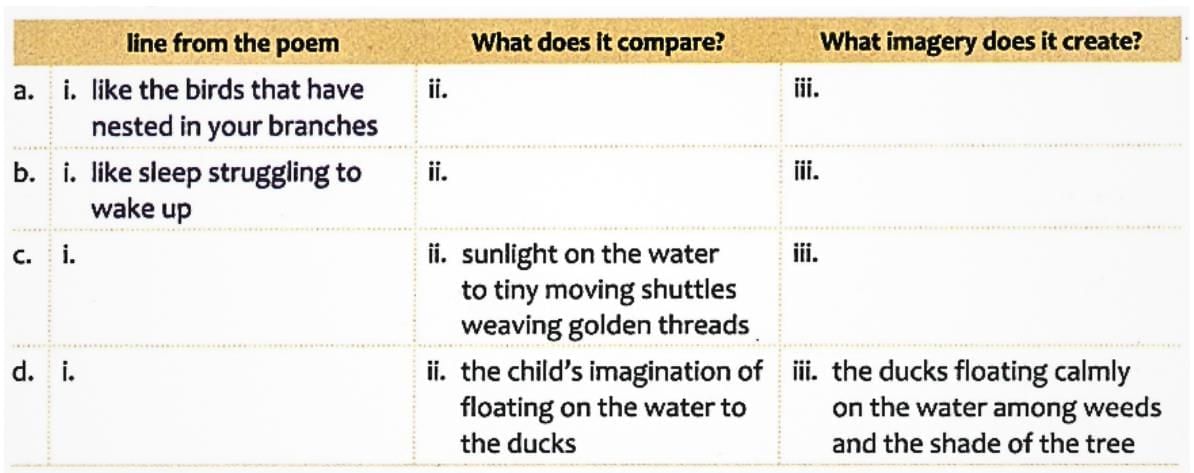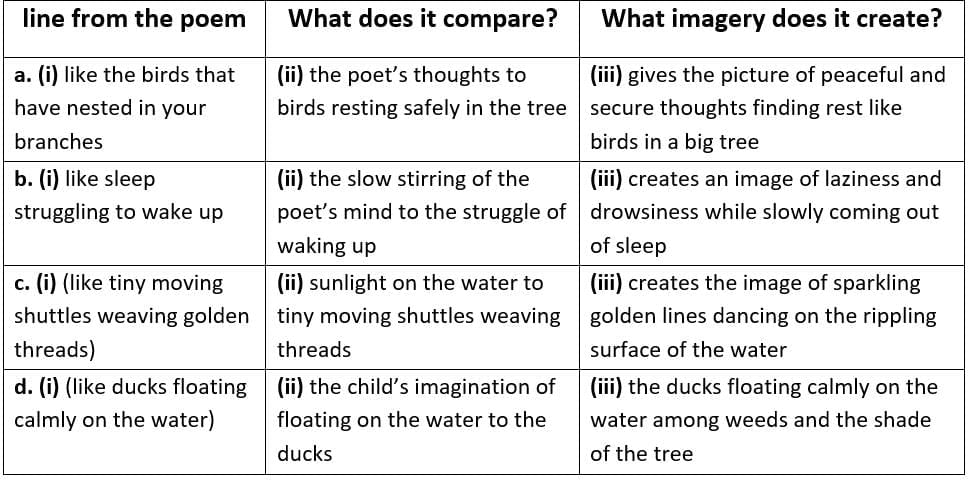Textbook Solutions: The Banyan Tree | Gul Mohar Class 6: Book Solutions, Summaries & Worksheets PDF Download
Understanding the Poem
Q1: Who do you think is the speaker of the poem? Who is the poem addressed to?
Ans: The speaker is the grown-up poet recalling his childhood memories. The poem is addressed to the banyan tree.
Q2: In what way does the speaker compare himself with the birds that used to live in the banyan tree?
Ans: The speaker says he, like the birds, once lived close to the tree but has now left, showing a sense of departure and memory.
Q3: Do you not remember … plunged underground? Underline three things that the speaker describes in these lines.
a. where the boy sat
b. what the boy thought
c. what the tree saw
d. how the tree's roots appeared
e. what the tree remembers
Ans: a. Where the boy sat – at the window.
b. What the boy thought – he wondered at the tree’s roots.
d. How the tree’s roots appeared – as a tangled mass plunging underground.
These are the three descriptions underlined in that part of the poem.
Q4: … your huge black shadow would wriggle on the water …
a. When and why would the tree's shadow move in this manner?
Ans: When the women came to fill their jars at the pond, the shadow moved because of rippling water.
b. What has the shadow been compared to? Why?
Ans: It is compared to sleep struggling to wake up, because of its restless, shifting movement.
Q5: What are the different ways in which the child wished to be near the tree? Did he want to simply sit near it?
Ans: No, he wanted to be the wind blowing through its branches, its shadow stretching on water, a bird on its twig, and a duck floating nearby.
Q6: This poem is called 'The Banyan Tree', but it also describes another thing in nature. What is that? What does the poem say about it?
Ans: It also describes the pond. The poem shows sunlight dancing on its ripples, ducks swimming peacefully, and shadows playing across it.
Appreciating the Poem
Q1: This poem includes many comparisons, using the word 'like'. Complete this table to explain those comparisons.
Ans: 
Q2: Think about the scene the poem creates in the reader's mind, similar to the one in the illustration.
a. Which sounds do you think would be heard near the banyan tree?
Ans: Sounds of rustling leaves, birds chirping, ducks swimming, and women filling jars.
b. Which of these words would you use to describe the scene? Ans: Words that can be used to describe the scene: bright, green, peaceful, quiet
Ans: Words that can be used to describe the scene: bright, green, peaceful, quiet
The banyan tree provided a calm and shady place. It was green all around, bright with sunlight filtering through the leaves, and the surroundings often felt peaceful and quiet, perfect for sitting and watching nature.
Q3: In the last stanza, the poet uses the phrase longed to be. What does this phrase tell you about how much the speaker enjoyed spending time in nature? Would this stanza have had the same effect if the poet had used the words 'wanted' or 'wished', instead?
Ans: The phrase shows a deep yearning and love for nature, stronger than just “wanting” or “wishing.” Using “longed” makes the stanza more emotional and heartfelt.
|
30 videos|61 docs|17 tests
|
FAQs on Textbook Solutions: The Banyan Tree - Gul Mohar Class 6: Book Solutions, Summaries & Worksheets
| 1. What is the central theme of "The Banyan Tree"? |  |
| 2. How does the poem describe the banyan tree's relationship with its surroundings? |  |
| 3. What literary devices are used in "The Banyan Tree"? |  |
| 4. What emotions does the poem evoke in readers? |  |
| 5. How does the banyan tree symbolize wisdom and endurance in the poem? |  |





















